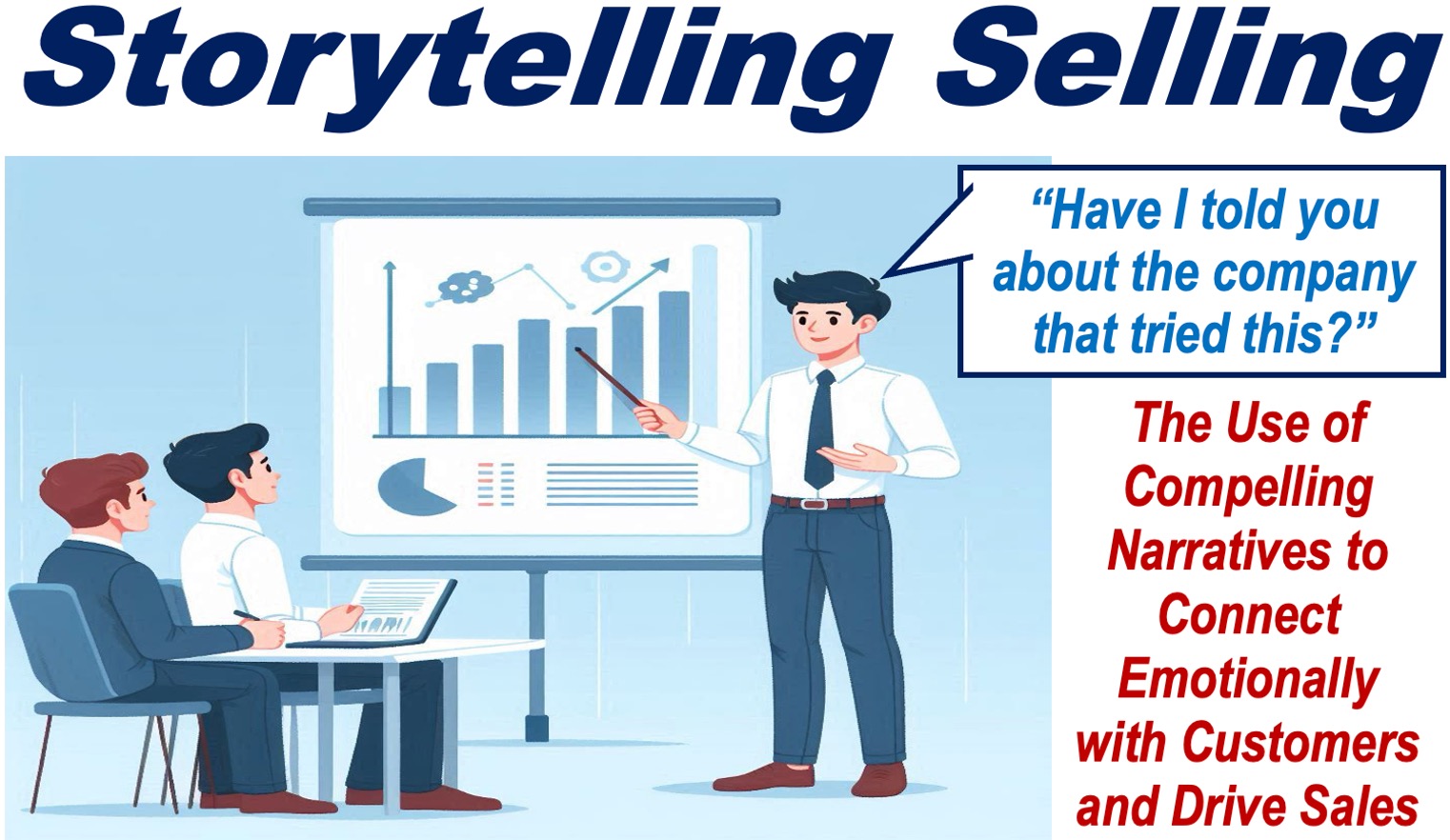Storytelling Selling or Storytelling in Sales is a sales technique where you use the power of narrative to connect with your customers on a deeper, more emotional level. Instead of just presenting facts, figures, and product details, you craft a compelling story that resonates with your audience.
This approach can make your product or service more memorable and relatable, which can ultimately lead to higher engagement and sales.
Mtdsalestraining.com has the following definition of storytelling in sales:
“Storytelling in sales is the art of using narrative structures to convey the value of a product or service.”
“Instead of simply listing features and benefits, storytelling brings those elements to life, placing them within a context that the audience can relate to.”
Selling an Experience
When you use storytelling in selling, you are not just selling a product; you are selling an experience or a solution to a problem.
Think about the last time you were truly captivated by a story. Maybe it was a book, a movie, or even a personal anecdote from a friend. The story likely had a beginning, middle, and end, and it might have included challenges, triumphs, or lessons learned. The same elements can be applied to selling.

Gathering Information
To craft a story that resonates, start by gathering information about your prospect through thoughtful questions.
Find out what their challenges, goals, and needs are. When they answer your questions, listen carefully. Listening is as important as talking in sales; in fact, some salespeople believe that listening is even more important.
Use this knowledge to align your story with their specific situation, making it relevant and compelling.
When your prospect sees that your story directly addresses their concerns, they’ll feel understood and valued, increasing the likelihood of engagement and a successful sale.
How Does Storytelling Selling Work?
You promote your product by weaving it into a narrative that illustrates its value in a real-world context.
For example, instead of simply listing the features of a product, you might tell a story about a customer who faced a specific problem and how your product provided the perfect solution.
By doing this, you create an emotional connection with your *prospect or customer, making your product more relatable and appealing.
* A prospect is someone who might become a paying customer. In this article, when you see the word ‘customer,’ it also refers to ‘prospect,’ and vice versa. The same applies to ‘product’ and ‘service.’
-
Story’s Structure
You need to make sure that your story has a structure. It should have a clear problem, a turning point, and a resolution.
Start by identifying the problem or challenge your customer faces. Then, introduce your product as the turning point that leads to a solution.
Finally, conclude with a resolution that highlights the positive outcomes your customer can expect.
Why is Storytelling Selling Effective?
Storytelling Selling is effective because it taps into the way we naturally process information.
Humans are wired to respond to stories—they engage our emotions, help us remember information, and make complex concepts easier to understand.
When you tell a story, you are not just presenting information; you are creating an experience that your customer can relate to on a personal level.
With this approach, you and your product will stand out in a sea of competitors. Although many businesses may also offer products like yours, the way you present yours through storytelling sets you apart.
By sharing stories that resonate with your customer, you build trust and credibility, making it more likely that they will choose your product over others.
Other Similar Selling Methods
Several sales methods share similarities with the principles of storytelling in sales, though each emphasizes different aspects. Here are eight examples:
Uses narratives to challenge the prospect’s thinking and introduce new perspectives, making the approach more relatable.
Relies on uncovering unique insights, often shared through stories to align with the buyer’s needs.
Builds trust through emotional connections, using stories to deepen relationships and create empathy.
Focuses on presenting tailored solutions, using examples or stories to demonstrate effectiveness.
Simplifies decisions by using clear, concise stories to make complex solutions relatable.
Matches solutions to customer needs, with stories illustrating how similar needs were met.
Uses stories to provoke new thinking and highlight risks of the status quo, guiding the prospect toward your solution.
Demonstrates value through narratives that showcase real-world examples, making benefits more tangible.
Companies that Utilize Storytelling Selling
These companies connect with their audiences by making their products and services feel essential and personal through storytelling.
-
Apple
Apple sells more than just products; they sell a vision of innovation and connection, using stories to show how their devices enhance daily life.
-
Nike
Nike’s “Just Do It” campaign tells inspiring stories of athletes overcoming challenges, motivating customers to push their own limits.
-
Coca-Cola
Coca-Cola’s campaigns focus on happiness and togetherness, using stories that link their product to positive emotions.
-
Airbnb
Airbnb shares stories from hosts and guests, highlighting unique travel experiences and meaningful connections.
-
IKEA
IKEA uses storytelling to show how their products improve everyday life, featuring relatable stories of home transformation.
Brief History of Storytelling Selling
The concept of using storytelling in sales has been around for decades. We don’t know when the term ‘storytelling selling’ emerged in the English language.
The practice gained traction in the early 2000s as marketers and sales professionals began to recognize the power of narrative in influencing customer decisions.
Over the last couple of decades, storytelling selling has grown in popularity, particularly with the rise of content marketing and customer-centric sales strategies.
Final Thoughts
Storytelling selling is a powerful tool that can help you connect with your customers on a deeper level.
By incorporating narratives into your sales approach, you can make your product or service more memorable, relatable, and compelling.
Whether you are selling a product, a service, or an idea, storytelling can be the key to engaging your audience and boosting your sales.
